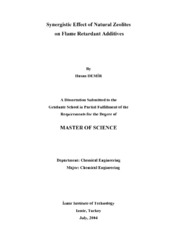Please use this identifier to cite or link to this item:
https://hdl.handle.net/11147/3408| Title: | Synergistic Effect of Natural Zeolites on Flame Retardant Additives | Authors: | Demir, Hasan | Advisors: | Ülkü, Semra | Publisher: | 01. Izmir Institute of Technology | Abstract: | Intumescent flame retardant systems were proposed to increase flame retardancy performance of polymers without environmental hazard. An intumescent system consisting of ammonium polyphosphate (APP) as an acid source and blowing agent, pentaerythritol (PER) as a carbonific agent and natural zeolite (clinoptilolite, Gördes II) as a synergistic agent was used in this study for flame retardancy of polypropylene (PP). APP and PER combination were examined at different ratios (0.25, 0.33, 0.5, 1, 2, 3, and 4) for optimization of formulation of flame retardancy. The zeolite was incorporated into flame retardant formulation at four different concentrations (1,2, 5, and 10wt%) to investigate synergism with the flame retardant materials. Filler content was fixed at 30w% of total amounts of flame retardant PP composites. The zeolite and APP were treated with two different coupling agents namely, 3-(trimethoxysilyl)-1-Propanethiol and (3-aminopropyl)-triethoxysilane for consideration influence of surface treatments on mechanical properties and flame retardant performance of composites.To investigate thermal behaviour of flame retardant PP composites with and without zeolite, samples were heated on optic microscope hot stage. Both of the composites behaved similarly during heating from room temperature to 203oC. Molten pentaerythritol was observed as a second phase in molten polypropylene at 203 oC. Bubble formations were not observed. Flame retardants did not cause any foam formation during processing of mixture at 190oC in rheomixer and hot press. SEM pictures of non-burnt and burnt flame retardant (FR) PP composites with and without zeolites did not reveal significant difference considering foam size and shape compared to composites without zeolite. Zeolite crystals did not exhibit any deformation during burning of composite.Flammability of FR-PP composites were determined by UL-94 flame test in air. Burning rate of composite was measured for flammable composite in atmospheric condition. The limiting oxygen index (LOI) test method provided measuring the minimum concentration of oxygen in a flowing mixture of oxygen and nitrogen that supports combustion of pure PP, zeolite reinforced PP and flame retardant PP composites. The best flame retardant performance was achieved with APP:PER(3:1)+PP+2% zeolite and APP:PER(2:1)+PP+5% zeolite formulations, exhibiting 37.4 and 38% LOI values respectively. LOI values reached maximum value 41% with mercapto silane treated APP:PER(2:1) at 5w% Zeolite PP composite Young's modulus of composites decreased with increasing amounts of APP in composite on the contrary to their elongation at break properties. | Description: | Thesis (Master)--İzmir Institute of Technology, Chemical Engineering, İzmir, 2004 Includes bibliographical references (leaves: 93-97) Text in English; Abstract: Turkish and English 97 - 92 leaves |
URI: | http://hdl.handle.net/11147/3408 |
| Appears in Collections: | Master Degree / Yüksek Lisans Tezleri |
Files in This Item:
| File | Description | Size | Format | |
|---|---|---|---|---|
| T000514.pdf | MasterThesis | 2.42 MB | Adobe PDF |  View/Open |
CORE Recommender
Page view(s)
278
checked on Feb 3, 2025
Download(s)
590
checked on Feb 3, 2025
Google ScholarTM
Check
Items in GCRIS Repository are protected by copyright, with all rights reserved, unless otherwise indicated.